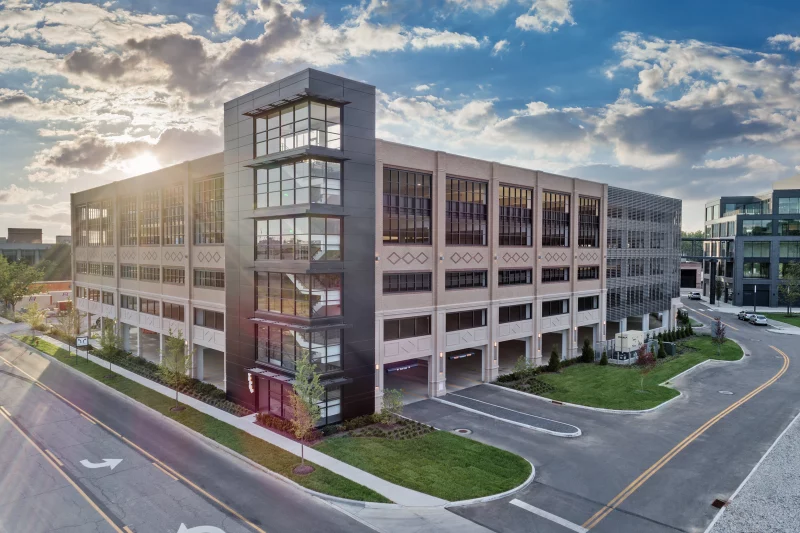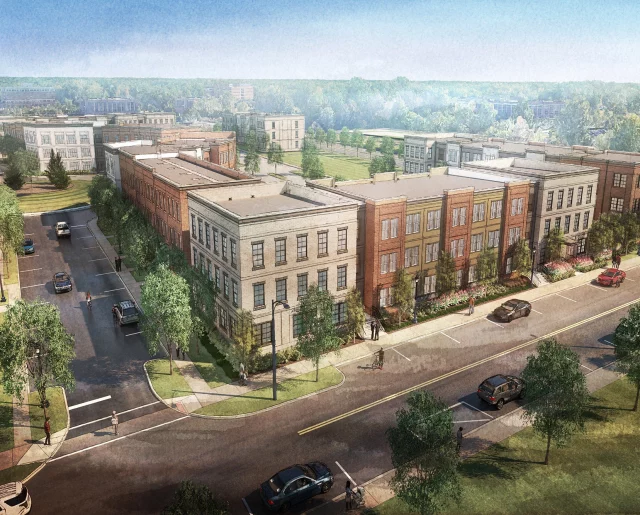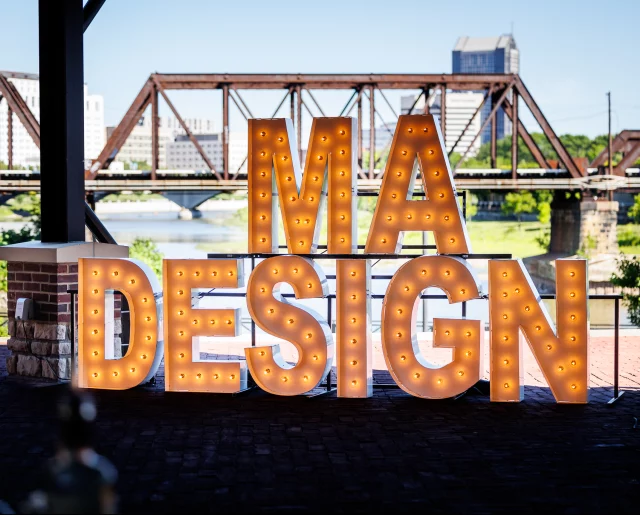Electric Cars Aren’t Next – They’re Now – So How Will Parking and Parking Garages Change in Response?
Electric cars might feel futuristic, but the fact is, they’re becoming our reality now – which means we need to start preparing for what’s next.
By 2030 there will be a significant amount of electric cars on the road, and with parking garages taking 2-3 years to construct, plans and projects must begin to accommodate this new “normal”.

After all, people don’t plan to fail – they fail to plan. This article is what you need to know now, for what’s to come next, and how to start planning today for tomorrow’s success.
Proof of a Greater Plan to Move to Electric Cars by 2030
The shift from traditional gas-fueled cars to electric cars on America’s highways is accelerating (pun intended) and proving to no longer be a concept of the future but a reality of now. Still don’t believe it? There’s proof:
- In March Ford released the Mustang Mach E, announcing their commitment to spend over 20 billion dollars in a move to go all-electric.
- Volkswagen has released the ID.4, and has committed to spending over 80 Billion Dollars with a plan to go all-electric by 2026.
- GM released 2 new vehicles in its line of Bolt electric cars, and plans to sell 30 different electric vehicles by 2025 (Including the new Hummer line) and is investing over $25 Billion Dollars in a plan to go all-electric by 2035.
- And not to be outdone Volvo announced its plans to go all-electric by 2030.
- Hyundai, KIA, and Toyota also have electric vehicles stalking dealer showrooms.
The average life of a vehicle on America’s roads is estimated to be between 8 years (Consumer Reports) and 12 years (AARP).
With these announcements, and analytics, in mind, a large share of American cars will be electric by 2030, and the majority of all vehicles on the road will be electric before 2040.
For us, that means planners and designers need to make sure we are designing to accommodate that future. By now, you might get the gist, but the code expert in me is ready to take it up a notch, so if you’re ready for more details and discussion – keep reading.

The Details and Discussion of the Mass Adoption of Electric Vehicles
A lot of thought has been put into the mass adoption of electric vehicles on the impact to our electrical grid and the demand for oil and climate change, but a lesser considered topic is the impact to urban planning, building codes and the built environment.
Currently, there are three levels of vehicle charging, that impact how long their car needs to charge before getting them back on the road.
- Level I – Car Chargers run at 120 volts (The same voltage from a standard electrical outlet) and provide enough charge for a distance of 4-5 miles per an hour of plug time.
- Level II – Car Chargers run at 220-240 volts (The same voltage as a standard electric clothes dryer and use a variety of NEMA outlets) and provide enough charge for a distance of 12-60 miles per an hour of plug time.
- Level III- Also known as DC fast charge using direct current and will charge most electrical vehicles to 50 to 80% of their capacity within 30 minutes (Roughly 300 miles per an hour of plug time). A newer version of this technology is in the pipeline that could cut this in half.
Most buildings are connected to the electric grid and therefore any building could be a “gas” station and even if it’s not connected that doesn’t mean solar panels, or other renewable sources couldn’t fill the need.
With that in mind we as planners need to ask ourselves, where does it make sense to make charging available? Should it be ubiquitous where every parking spot across the country becomes an opportunity to refuel or should it be laissez-faire with standalone charging networks and businesses competing to use our captive refuel times to their commercial advantage?
Proposed Building Code Changes to Accommodate the Future
I’m a building code expert – and admittedly – nerd out on the idea of how it can be best utilized – or changed – to support the future evolutions of our reality. It only felt fitting that I evaluated the current standards and find areas for improvement.

Regardless of your free-market mentality, there is one place where building and zoning codes should make changes to accommodate electric vehicles, and its where the majority of American’s will recharge for their daily commute, the play where we lay our head down at night, the home or home away from home. So with that in mind Building and Zoning Codes should consider:
- New homes and condominiums are provided with a level II car charger where a vehicle is parked.
- Level II chargers for 10% of open parking spaces at Apartment Structures with the remaining spaces provided access to a level I car charger for daily commuters.
- Hotels to have access to Level II charges for 50% of rooms or to provide valet service that could rotate vehicles onto level II or level III Chargers.
- Regional destinations and public and private parking serving professional sporting and entertainment events to provide 15% of spaces with level II chargers or provide valet service that could rotate vehicles onto level II or level III Chargers.
Private Businesses looking to capitalize should consider:
- Fast-casual and casual dining located at major highway exits to provide level III fast chargers for 10% of all parking spaces. (As determined by local zoning)
- 2% of all parking with Level III chargers and an additional 5% with level II chargers at mercantile occupancies with occupant loads greater than 300 people or near major highway exits.
- Infrastructure for 5% of parking spaces to be provided with level III fast chargers and an additional 5% of spaces with level II charging in all parking garages not serving any of the above-defined uses.
The 2021 model building code will require that 5% of all vehicle chargers be accessible. This will help in providing disabled Americans access to vehicle charging, but will not provide the equitable access disabled American’s have become accustomed to. This is not to say every accessible space must be provided with vehicle charging, just as not every non-accessible parking space will, but unless vehicle chargers are located at a portion of accessible and van accessible parking spaces, disabled Americans may not enjoy the same freedoms as able-bodied American’s to be able to charge their vehicle and have ease of access to mercantile and dining. To accommodate disabled American’s we should:
- Provide 25% of accessible parking spaces with 4 or more spaces with (1) level II vehicle charger located at a van accessible parking space. In addition, I would recommend that as required by the model code that 5% of vehicle chargers provided for general use be provided with accessible aisles to accommodate disabled Americans.
Currently, the 2021 model code requires wet sprinklers in open parking garages with a floor area greater than 48,000 sf per floor. However, a wet sprinkler fails to directly apply water to the source of vehicle fires: the battery, and without direct application to the battery sprinklers will have almost no impact.
Instead, heat-based fire detectors through infrared cameras could detect the potential for a fire. From there, fire departments can be contacted to successfully put out a fire, possibly before it even becomes an actual fire, because vehicle battery fires due to thermal runaway are often slow to start but burn hot. It’s details like these that make a design successful, and while seemingly insignificant, can have a tremendous impact on the success of the project – particularly once activated with human interaction.
Turning the Conversation into Action
If you’re interested in learning more or working together to plan now for what’s next, feel free to email me at kurtb@designwithma.com. I’m excited for the future, and confident in my ability to utilize code to best plan and prepare for our next evolution of reality.
Who doesn’t love cars, and electric cars – well that’s just cool times 10? When I’m sitting here imagining the future I get excited by the opportunities electric cars bring because…
15 minutes…. That’s the time I spend filling my car up with gas each week. With convenient electric charging at home, I will get back 6 ½ hours a year to do things more important than keeping an eye on my tank.
Wiz… Bang, so yes that’s a Roomba vacuuming my house, and an electric lawnmower and edger in my garage, so I’m a nerd, I think these are cool and electric cars are cool. They accelerate faster and have more torque than gasoline cars, and I can fuel it up in my garage while watching a movie. If we ever do figure out self-driving cars, making them all-electric will be easier. After all, it’s synergy to imagine that maybe one day just like our phone we will have cars that wirelessly charge when parked and take care of finding a charging station on their own.
Green… you didn’t think I was going to skip this one, did you? But maybe not for the reason you think. We already know all about vehicle emissions and smog, that’s a given. But as an architect who has worked on projects reclaiming the site of former gas stations I know that those underground tanks leak gas into our underground aquifers and poison nearby soils. In an electric future, we can clean up those gas stations and turn them into awesome restaurants, better fuel for my belly than fuel in the dirt.















